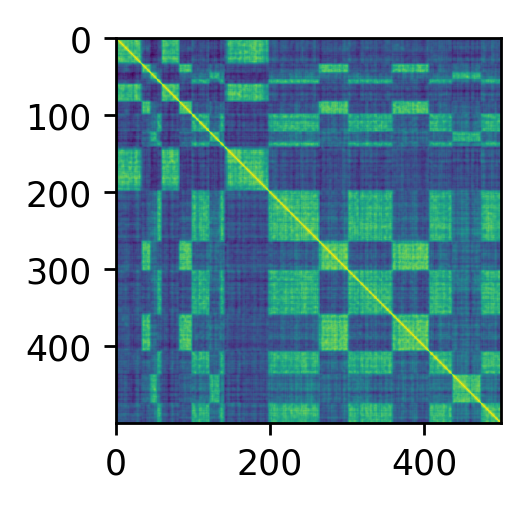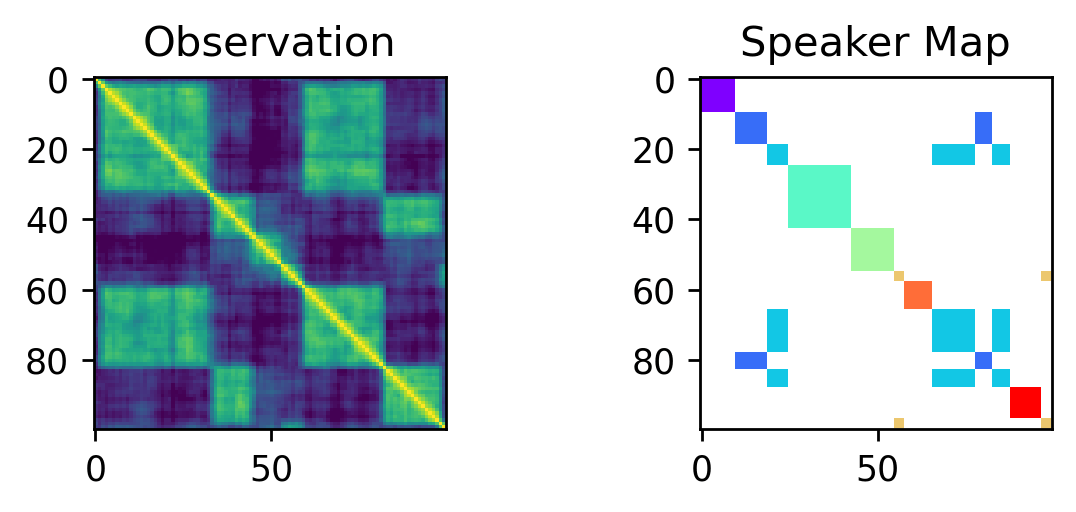One of our “northstar” projects at cgn.ai is indexing the podcast universe — any data of spoken words really. An important piece in our pipeline is speaker segmentation (diarization), i.e. the segmentation of an audio track into different speaker tracks, answereing who spoke when.
Along those lines we explored different approaches to tackle this problem, including a probabilistic approach where we build a probabilistic speaker segmentation model in Gen. Gen is a general-purpose probabilistic programming system, embedded in Julia.
The notebook can be found on our public repo at:
We define a model that generates speaker similarity matrices of a given size. In practice such matrices are constructed by creating voice embeddings $X$ vor a given wav file, and computing their similarity, i.e.
\[D = X X^T.\]To be more precise let $w_i$ and $w_j$ be two audio snippets from a given wav file and let $x_i$ and $x_j$ define their vector embeddings, then the $ij$’th eintry is given by
\[d_{i,j} = \langle x_i , x_j \rangle\]Here is a real world example of such a similarity matrix:

In contrast, here are a few samples from our probabilistic model:

Inference - Reversible Jump MCMC:

Excerpt from the notebook:
"""
matrix_model(M::Int "Max number of speakers",
T::Int "Size of the matrix (or length of the track)",
k::Int "Size of the observation band around diagonal",
poisson_rate::Float64 "Parameter shaping the `:num_segments` distribution")
Speaker similarity-matrix model.
"""
@gen function matrix_model(M::Int, T::Int, k::Int, poisson_rate::Float64)
#
# Sampling the number of segments `N` and
# their lengths `ls`, and computing
# their enpoints `ps`
#
N = {:num_segments} ~ poisson_plus_one(poisson_rate)
ls = {:len_segments} ~ dirichlet(N, 2.0)
ps = cumsum(ls)
ps[end] = 1.0 # Correct numeric issue: `ps[end]` might be 0.999999
#
# Sampling speaker ids for each segment
#
ids = [{(:id, i)} ~ categorical(ones(M)./M) for i=1:N]
#
# Mapping speaker ids to
# individual ticks.
#
xs = collect(0:1/(T-1):1)
I = [findfirst(p -> p >= x , ps) for x in xs]
ys = ids[I]
#
# Sampling entries for the similarity matrix. We distinguish
# 3 different cases:
# - Diagonal entries
# - Same speaker
# - Different speaker
#
# TODO: One could extend this by varying the values based on
# speaker similarity
#
D = zeros(T,T)
for i in 1:T, j in max(i-k,1):min(i+k,T)
if i == j
# The voice embeddings are normalized so on the
# diagonal the entries are 1.
# TODO: Don't need a random choice here really ...
D[i,j] = {:D => (i, j)} ~ normal(1, sqrt(0.001))
else
# Off-diagonal entries ramp down
# from 0.9 towards 0.5
off = 6
r = 1 - min(abs(i-j), off)/off
r = r^2
if ys[i] == ys[j]
D[i,j] = {:D => (i, j)} ~ normal(r*0.8 + (1-r)*0.5, sqrt(0.01))
else
D[i,j] = {:D => (i, j)} ~ normal(0.15, sqrt(0.007))
end
end
end
return Dict(
:T => T,
:N => N,
:ids => ids,
:xs => xs,
:ys => ys,
:D => D,
:ps => ps,
:ls => ls)
end;